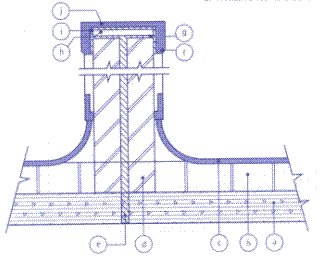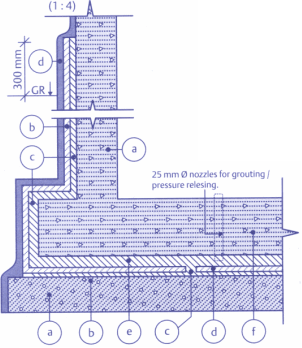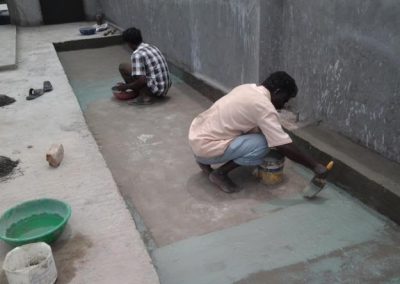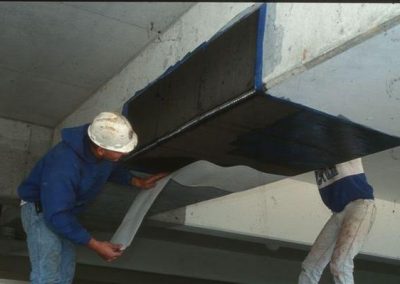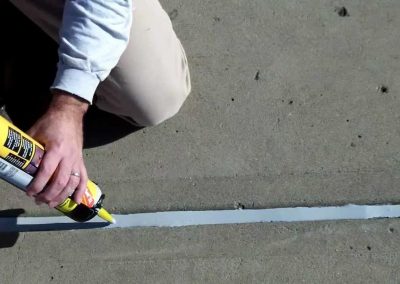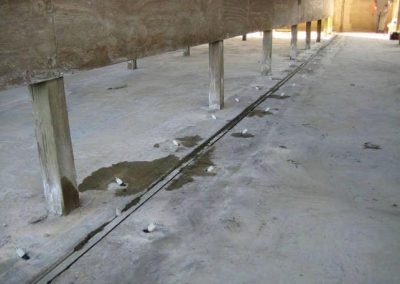Expansion Joints
Expansion Joints
The main contractor shall first provide 4″ thick-18″ height brick masonry on the Slab floor ; above which we shall provide 24 Gauge Aluminium sheet/170 GSM Fiber mesh with a grove in the centre and overlapping on one side the other side shall be up to the edge of Brick masonry. The grove shall be filled with plain paper the same paper shall be pasted with cement paste on the top of Aluminium Sheet/ Fiber mesh above which over average 110 mm Brick-bat will be laid after filling he joints of Brick-bar in C.S. mortar, We shall fix wire-mesh on it and finally the top will be finished in smooth cement colour with overlapping on both sides of brick masonry. Expansion joints can also be treated by filling the gap with Poly-Sulphate Sealant.
- RCC Slab.
- Brick Bat laid on terrace
- Top finish on terrace.
- 115mm TO 450mm the. Brick wall
- ‘SHAUTEX’ Board to be provided by ARDEX ENDURA
- Aluminium Sheet/170 GSM Fiber mesh
- Paper
- Brick Bat
- Wire mesh.
- TOP finish
ADVANTAGES OF “SEALROOF” PROCESS
- The “Seal roof” Process is of permanent nature and once done will not need attendance for a long time.
- The “Seal roof” process being of permanent nature is cheap in the long run-though initially slight costly, as it does not require maintenance viz. Periodic repair and/or replacement after a period.
- The “Seal roof” treatment is covered with guarantee of ten years from date of completion against any defect inadvertently left out by the workers
- The “Seal roof” treatment based on cement can withstand the same temperature as the R.C.C. structure in metal foundries, steel plants and re-rolling mills etc.
- The “Seal roof” treatment is a non-conductor of heat unlike bit mastic treatment. So the terraces treated with our “Seal roof” treatment tend to keep the areas below comparatively cooler in summer and warmer in winter.
- If however a decorative surface is desired on it. Since it is finished in cement, it can also take that.
- The “Seal roof” Process on terrace or other horizontal surfaces provides a hard and tough surface suitable for all normal domestic purposes. Since it is sufficiently strong, it does not need any further protective layer.
- The “Seal roof” surface on the wall can be painted in pleasing colours with any kind of paint.
- The “Sealroof” treated terrace can be converted into a beautiful lawn and/or a garden.
Process
although our waterproofing method is little complex, we give three options to our customer to suit his need and the budget. The difference is in the specifications.
The building which has plans to go for re-development in the near future need not go for the expensive options.
The unique design created on the dead walls
It is essential to understand that the waterproofing of a building cannot be done in patches or locally where the leakage is seen. It is necessary to cover the entire building or else it is waste of money, waste of time and only frustration.
Generally the following steps are adopted
the surface is cleaned with high pressure water jet; the cracks are cut opened and filled in with specialized mortar. Metal insertions are properly covered and the entire surface is coated with ‘Xailexcon’. The surface is then coated with our specialized composite material made out of M. M. Stone Polymer + proprietary chemicals SK027 + DM054 + White sand + Cement in three coats, either by brush or trovel. The material is mixed at the site in various combinations and proportions as per the site requirements. The surface is then painted in the desired shade.
When it is found necessary, the work such as re-location of pipes, PCM treatment on damaged RCC members, re-plastering in patches is carried out before the main treatment is done.
A unique treatment is carried out on the large uninterrupted plain surface of dead wall which is subjected to the constant thermal variations. This do not allow easy cracking of the surface and the performance lasts for long. No other treatment is so effective on the plain wall
Our waterproofing system is excellent after carrying out major repairs on a building. The joints which are formed during the patching-up cannot be sealed otherwise.
BASEMENT BY “BOX” METHOD USING SHAHABAD STONE
We propose to treat the U/G Structure by our ‘Box Method’ For this we would require 150mm (6′) thick layer of cement concrete (1:3:6) P.C.C. using metal upto No 2 laid even with smooth surface with wooden trowels by the owners on well compacted soil or rubble soling or plain concrete.
The bottom P.C.C. should be laid in such way that it shall project minimum 6′ (150 mm)
Beyond the face of bottom P.C.C. Raht on all sides. On the P.C.C. we shall provide our ‘SEALROOF’ waterproof layer C.M. of 1″ thick on which stone aggregate of nominal size will be embedded at random.
We shall provide Shahabad rough ladi (stone) of about 1 to 2 feet square and of 20 to 25mm thick fixed in C.M. (1:4) above the ladi we shall again provide our “Sealroof” Waterproof layer of 1/2″ to 3/4″ thick. Like this the total thickness of our treatment becomes of 3″ thick. This is then super imposed by the owner with R.C.C. Raft.
After casting of R.C.C. Raft and side walls by the owners, the outer face of the walls are provided with our Shahabad ladi and then grouted with cement slurry, above the ladi we shall provide 1/2″ to 3/4″ thick “Sealroof” waterproof layer, like wise out treatment becomes of about 1 3/4 thick. The outer treatment is carried out upto a height of about one foot above ground level.
The excavated portion of the sides around is then of simultaneously with our work is filled in by the owners with soft earth.
By this method the entire structure is encased by our treatment and the attacking subsoil water will not find an access to it.
IMPORTANT:
- As already stated above, the earth filling on the outside wall shall be done by the owners. Simultaneously with the progress of our work on the outer face of the walls.
- No injection in any other treatment is given to the walls inside as a part of the above or otherwise.
- Expansion joints, in the basement floor and wall are not needed.
SIDE WALL
- R.C.C. Side wall.
- Shahabad rough ladi fixed in fine cement paste.
- Neat cement slurry filled in between R.C.C. wall & shahabad ladi
- Top smooth finish in cement mortar.
FLOORING
- P.C.C. (150 mm) thick to be laid by owner.
- Stone Aggregate fixed by hand cement mortar (1.5)
- Cement mortar (1:4) laid for fixing rough Shahabad ladi
- Shahabad ladi fixed in cement mortar.
- Top finish in cement mortar (1:4)
- R.C.C. Raft slab laid.
Note: Soft earth filling on the outer face shall be done by owner simultaneously with the progress of water proofing work.
BASEMENT BY "INJECTION & SURFACE" METHOD
In case of existing Basement where no access is available for treating the surface from outside and below. We propose to treat the U/G structure by our “Injection & Surface” Method.
The junction of the bottom raft with the vertical wall is to be opened by us and filled with the vertical wall is to be opened by us and filled with metal aggregate of nominal size along with injection (coupling). In the wall area all construction joints are opened to provide Injections. Injections shall be provided as and where found necessary are Bu us as per site conditions. The injections are filled with cement slurry (grouting).
After the injections are finished with cement grouting. We shall provide a layer of I.P.S. of about 2″ thick on the floor and the vertical wall is covered with out “Sealroof” water proof layer of about 1″ thick like this the structure is waterproofed from inside.
Note: This method is also applicable for Underground tanks. Lift Pits and Overhead water tanks.
The final surface of the floor will be finished smooth in cement colour and that of the Walls with cement / neeru finish.
If however. It is desired to provide tilling over our treatment then the surface of our treatment will be finished in a manner to receive the tiles. It may please be noted that our treatment should in no manner be punctured or damaged. If any fixtures are necessary, then they will be provided on a protective wall, to be provided over our treatment. So that our treatment is not damaged of tampered with.
In case the floor of the basement is to be subjected to rough and/or heavy use. Then a Suitable wearing coat on our surface shall be necessary to be provided by the owners.
In case any existing treatment is present, the same shall be removed by us to expose The surface of R.C.C. Raft.
- R.C.C. Slab.
- R.C.C. Wall.
- R.C.C. junction.
- 25 mm mild steel nozzles.
- 25 mm thick ‘SEAL ROOF’ cement plaster in Two layers.
- 20 mm thick First layer of ‘SEAL ROOF’ cement mortar (1:4) with stone aggregate fixed by hand.
- 20 mm thick Second layer of ‘SEAL ROOF’ cement mortar (1:4) with stone aggregate fixed by hand.
- Top layer 20 mm thick ‘SEAL ROOF’ cement mortar (1:4) smooth\rough finish.
- 25 MM m.s. nozzles as per site conditions.
TERRACE WATERPROOFING BY "SURFACE" METHOD
In case of existing Basement where no access is available for treating the surface from outside and below. We propose to treat the U/G structure by our “Injection & Surface” Method.
The terrace is treated with our “Surface” method which starts directly over the R.C.C. Slab. The internal parapet or other adjoining walls shall be plastered leaving a space of about 18″ from the slab for our Wata (Golia). The R.C.C. Slab be well cleaned and rain water outlets pipes fitted by the owner before the commencement of our work.
- 1. The R.C.C. Slab shall be well cleaned with water and will be grouted/ flooded with cement slurry. Now we shall fix our “Brick bat” in C.M. with necessary gradient for the easy flow of rain water (the treatment shall then be cured for at least 48 hours).
- 2. The “Brick Bat” is finally covered with our “Sealroof” waterproof plaster finished with smooth trowels with false marking of 300mm squares or finished rough as desired by the owners/clients. Our treatment is carried along the vertical surface of parapets and other adjoining walls upto a height of about 1 foot in the shape of round Wata. The average thickness of our treatment is about 110mm (41/2″). The thickness at rain water outlet points being 75mm (3″). The maximum slope will be 1″ per 10 feet area.
- (A) The surface provided is hard and tough suitable for all normal domestic purposes. it has got better insulation value than the bitumastic.
- (B) If however, it is desired to cover our treatment with decorative tiles, marbles etc. then the surface of our treatment will be finished suitable to receive them.
- (C) Due to location of rain water pipes being for apart and due to the span being wider than 30′ or 9 meters and the water is required to travel on one side only then the thickness of our treatment increases proportionately to maintain the gradient for the easy flow of rain water.
- (D) In the case of existing terrace since our treatment starts directly over the R.C.C. slab es stated above, the existing treatment will have to be completely removed by us to expose the bare surface of the R.C.C. slab.
- (E)If a garden and/or a lawn in desired to be made over the treatment. It can be suitable for that also at extra charges.
- R.C.C. Slab
- Cement mortar laid for fixing of Brick Bat (1:5).
- Brick Bat fixed in cement mortar.
- Cement mortar laid for Top finishing (1:4)
- Top finished surface smooth or rough as desired.
Note: Average thickness of work is 110mmSlope is (1:120) 1 Inch in Every 10 Feet.
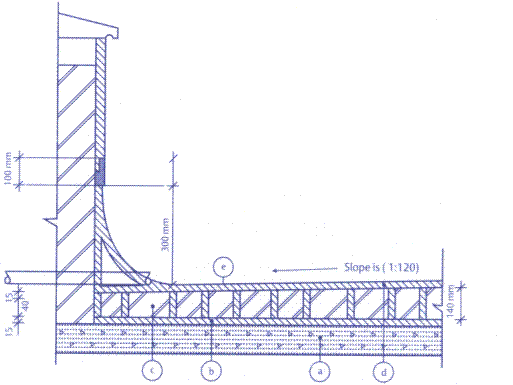
LOOKS INTERESTING ?
GET IN TOUCH

